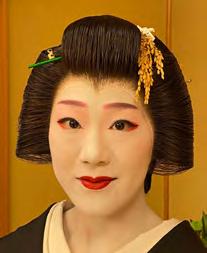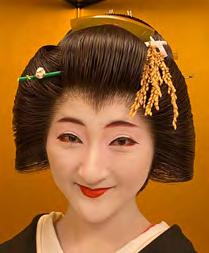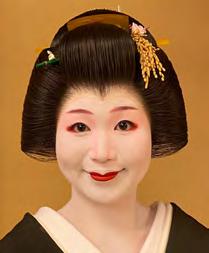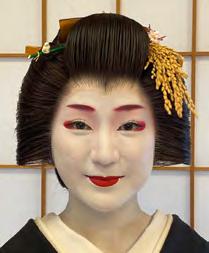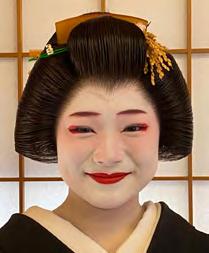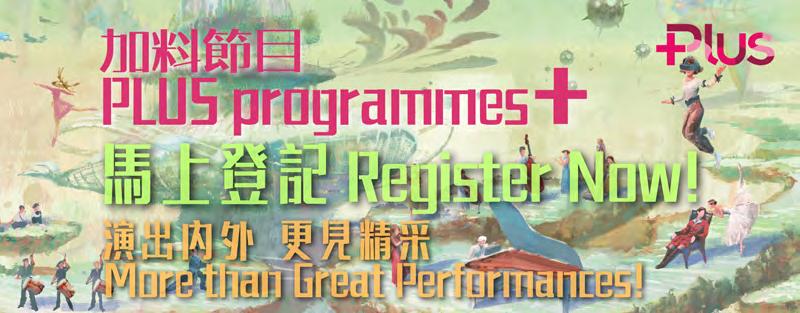Nagauta and Geisha Treasured Traditions of Japan

Please
04–05.03.2025 / 7:45pm Theatre, Hong Kong City Hall
Approximately one hour 30 minutes including one interval
House Rules
※ Please switch off mobile phones and all electronic devices so they will not emit sound or light during the performance, disturbing the performers and other audience members.
※ Unauthorised photography or recording of any kind is strictly prohibited.
※ Please keep noise to a minimum during the performance.
※ The content of all works is independently produced by the creative team, and does not reflect the views or opinions of the Sponsor.
※ The content of this programme and the opinions featured in this publication are solely those of the artists/guest writers and do not represent the views or opinions of the Hong Kong Arts Festival (“HKAF”).
※ Ticket holders are strongly advised to arrive punctually. The HKAF reserves the right to refuse the (a) admission of latecomers (whether at the beginning of the performance or after the intermission) and (b) re-admission of audience members who leave the auditorium during the performance.
※ The HKAF also reserves the sole discretion to determine the possibility of admission and re-admission of audience members (which includes latecomers and audience members who have left the auditorium and are seeking re-admission), as well as the manner in which they are admitted.
※ In any case, should the HKAF permit the admission of latecomers, such latecomers shall only be admitted at designated latecomer point(s). No refunds or changes will be offered if ticket holders are refused admission due to late arrival. In the event of any dispute, the HKAF reserves all rights to make the final decision.
※ The English versions of the house rules on the HKAF website and front-of-house announcements will prevail in the event of any dispute.





Chief Executive’s Message Contents
Chairman’s Message
Foreword
About Gokagai (“five flower districts”)
Programme A (4 March, 7:45pm)
– Repertoire
– Programme Notes
Programme B (5 March, 7:45pm)
– Repertoire
– Programme Notes
Creative, Production Team and Performers Interview
Creators’ and Performers’ Profiles
About the Hong Kong Arts Festival Dancers
Committee and Staff List
Acknowledgements
Message
I am pleased to congratulate the Hong Kong Arts Festival on the organisation of its 2025 season—the 53rd edition of one of the world’s most celebrated international cultural events.
This year’s Festival brings together over 1,300 international and local artists in some 125 performances covering music, dance, theatre, Chinese and Western opera and much more. The Festival-opening performance, by Italy’s Orchestra of the Teatro Comunale di Bologna, conducted by Maestro Donato Renzetti, features classic Italian opera arias. Renowned Chinese conductor Lü Jia and the China National Centre for the Performing Arts Orchestra, together with international pianist Zhang Haochen and soprano Song Yuanming, bring the Festival to a close in grand style.
Festival PLUS returns, presenting a wealth of artist-audience events, including masterclasses and workshops, backstage visits, guided cultural tours and more. Besides, the Festival’s “Young Friends” programme features school tours, pre-performance talks, arts demonstrations and other special events designed to engage local young people with a world of arts and culture.
The Government is determined to enhance the appeal of Hong Kong’s culture. To further solidify Hong Kong’s position as a vibrant Eastmeets-West centre for international cultural exchanges, the Government has launched the Blueprint for Arts and Culture and Creative Industries Development in November 2024, and has been actively working on the 71 measures under four key strategic directions as outlined in the Blueprint.
I am grateful to the Hong Kong Arts Festival and its dedicated team for their unremitting efforts in promoting arts and culture in Hong Kong, throughout the region and around the world. I am grateful, too, to the many sponsors and donors for their generous support for the Festival.
I wish this year’s Hong Kong Arts Festival another resplendent season of arts and culture, entertainment and memorable community engagement.

John KC LEE Chief Executive Hong Kong Special Administrative Region
Chairman’s Message
A warm welcome to the 53rd Hong Kong Arts Festival. As a leading international performing arts event, the Festival is continuing its mission of enhancing Hong Kong’s cultural landscape by showcasing over 1,300 exceptional international and local artists in more than 125 performances of over 45 unique programmes, as well as organising about 300 PLUS and educational activities for the community.
I would like to thank the HKSAR Government, acting through the Leisure and Cultural Services Department, for its annual subvention and matching grant which are not only essential to our operations, but also an important recognition of the work we do. I also want to thank The Hong Kong Jockey Club Charities Trust for its unwavering support during the past 53 years, as well as other corporate sponsors, charitable foundations and donors, whose contributions have enabled us to reach out to different sectors of the community and positively impact society through the performing arts.
My deepest gratitude goes to all participating artists for their dedication and exceptional performances. I also thank all HKAF staff, who worked extremely hard to bring this Festival to life.
Most importantly, I extend my heartfelt appreciation to all audience members for your participation and support. May you find joy and inspiration in our programmes and events.

Lo Kingman Chairman Hong Kong Arts Festival
Supporting Organisation:
Promoting international cultural exchange has always been a key objective of the Hong Kong Arts Festival. This year’s Festival continues to invite renowned global masters and internationally recognised young pioneers to present a range of worldclass programmes, respecting tradition while encouraging new, innovative initiatives. Many of these works are inspired by classic literature or offer rediscoveries of the original, bringing vibrant artistic experiences to the city.
We will also present a series of programmes centred around “fantasy and adventure”. These include works that seamlessly blend the arts with VR and AR technology, as well as captivating new creations that draw on traditional puppetry and circus performances. The Festival will also continue to support local artists and encourage exchanges to foster a vibrant and diversified platform for the arts.
We also remain dedicated to advancing arts education and audience building. Our PLUS programmes will present a series of thoughtfully curated masterclasses, backstage visits, post-performance artist talks and an exhibition. And our Young Friends and educational activities will continue to offer multidimensional arts experiences to students.
We hope that you will enjoy this year’s arts extravaganza prepared by the Hong Kong Arts Festival team.

Flora Yu Executive Director Hong Kong Arts Festival
The Hong Kong Arts Festival is made possible with the funding support of:



請支持您的藝術 節! Become a Supporter of Your Festival! P l ea se D on at e 請即捐 款 DONATE

Enq ui r ie s 查 詢: (852) 2828 4911
About Gokagai (“five flower districts”)
Kyoto is home to five historical geisha districts known as Gokagai (“five flower districts”), where the refined arts of the geiko (the Kyoto term for geisha) and maiko (apprentice geiko) continue to thrive. The Kamishichiken district is located near Kitano Tenmangu Shrine, while the other four—Gion Kobu, Gion Higashi, Miyagawacho and Pontocho—are clustered around Yasaka Shrine, a significant cultural landmark in Kyoto.

The geisha’s history in Kyoto can be traced back to the early Edo period in the 17th century. At the time, visitors going to Yasaka Shrine often stopped at teahouses and restaurants along the worshippers’ path, where proprietors and waitresses entertained them with dancing, singing and musical performances. Over time, these talented entertainers evolved into professional artists, giving rise to the geiko and maiko culture which remains an integral part of Kyoto’s heritage today.
In an effort to preserve and pass down the geisha districts’ rich traditions, the Kyoto Traditional Art Foundation was established in 1996. One of its most celebrated events is the Miyako no Nigiwai, an annual performance held every June. This performance gathers geiko and maiko from the five districts to showcase the elegance and refinement of this cultural tradition.
Each district functions as a tightknit community composed of ochaya (teahouses), okiya (geisha houses) and the geiko and maiko. An ochaya is an exclusive venue where guests experience traditional entertainment, while an okiya serves as the residence and training centre for maiko and young geiko under the mentorship of experienced proprietresses. Geiko and maiko dedicate their lives to mastering the traditional arts, including dancing, music and tea ceremony, ensuring the vibrancy of Kyoto’s cultural heritage.
The governance of each district is overseen by several organisations, including the Kabukai or Song and Dance Society, which regulates training, annual dance performances and recitals. Masters of the Gion Higashi Song and Dance Society include Meisho Tosha (Japanese flute/ Living National Treasure), Katsuroku Kineya (Nagauta, traditional Japanese long songs ), Kikusuke Kiyomoto (Kiyomoto singing), Jukaku Nakamura (drums), Mon Fujima (dance), Ryotoro Fujima (dance) and Sohaku Suzuki (Japanese tea ceremony).
Programme A Repertoire
Songs and Strings of Tradition
04.03.2025 / 7:45pm
Maidens of Three Shrines
INTERVAL
Four Seasons of Kyoto
Bridge of Gojo
Kanjincho
*Songs and their order of performance are subject to change
Programme A Programme Notes Contents
Programme A Programme Notes
Maidens of Three Shrines
Although the writer of the lyrics and music is unknown, this piece is based on the Okina category of Noh plays and is famous as a dedicatory dance at several shrines: Ise Jingu in Mie prefecture, Kasuga Taisha in Nara prefecture and Iwashimizu Hachimangu in Kyoto prefecture. The pilgrimage to these three shrines was popular in the Edo period.
As a ritual song to celebrate universal peace, a huge harvest and prosperity for 1,000 years, it is played at the New Year, framework raising and opening ceremony days. It uses a mikosuzu, an instrument with about 15 small bells attached to three rings on a stick with handle, which is used when shrine maidens dance a kagura (a specific type of Shinto theatrical dance). The music is tuned to three down beats and is rhythmical to convey a bustling feeling.
Kurama Mountain
Kurama Mountain was composed in 1856 by Kineya Katsusaburo II, based on the Noh song Kurama Tengu. The piece draws inspiration from a series of legends about Minamoto no Yoshitsune, focusing specifically on his childhood, when he was known as Ushiwakamaru.
After being saved by the gatekeeper Taira no Munekiyo, Ushiwakamaru was placed under the care of Kurama Temple. There, he discovered his lineage as a descendant of the Genji (Minamoto clan) and began rigorous nightly training in swordsmanship. This training was in preparation for his eventual goal of overthrowing the Heike (Taira clan). Notably, his legendary training partners were Sojobo, the great tengu (a mythical bird-like creature), and his subordinate, the leaf tengu

Four Seasons of Kyoto
This is a shamisen song by an anonymous songwriter that was popular in the Kyoto and Osaka areas during the late Edo shogunate. Wataru Murakami and Shojuro Matsushima created the new Nagauta (long song) version. The lyrics, centred around Gion, depict the seasonal scenery of various famous spots in Kyoto, such as the cherry blossoms in bloom in Higashiyama, the cool evening breezes along the Kamo River, the autumn leaves covering Chorakuji Temple and the snow-covered mountains. The piece’s elegant and refined melody, combined with accomplished dance techniques, subtly conveys the allure of Kyoto, contributing to its popularity as a performance piece at social gatherings and banquets.
Bridge of Gojo
Bridge of Gojo was composed by the 13th generation Rokusaemon Kineya (1870-1940) and completed around 1903. This piece depicts the scene of the encounter between Minamoto no Yoshitsune and his retainer Benkei. Ushiwakamaru (Yoshitsune’s childhood name), in search of a strong warrior worthy of the Minamoto clan, wanders the streets of Kyoto, while Benkei also roams the streets to test his own strength. The two meet on Gojo Bridge and engage in a fierce battle. Benkei is ultimately defeated by Ushiwakamaru and becomes his most loyal retainer.
Kanjincho
Kanjincho (“The Subscription List”) is a Kabuki dance-drama written by the third-generation Namiki Gohei and composed by the fourth-generation Kineya Rokusaburo, based on the Noh play Ataka. It is one of the most popular plays in the modern Kabuki repertory.
The story follows Minamoto no Yoshitsune and his followers disguised as yamabushi (mountain monks). They are collecting donations to rebuild the burned-down Todaiji Temple as they attempt to flee to the Ataka checkpoint in Kaga province. Their disguise raises the suspicions of the checkpoint commander, Togashi Saemon. With remarkable courage and quick thinking, Benkei recites a fake kanjicho and deceives Togashi, allowing Yoshitsune and his group to pass through.
Programme B
Repertoire
Songs and Strings of Tradition
05.03.2025 / 7:45pm
All Sorts of Pine Trees
Raccoon Dogs
Flow of Water
INTERVAL
A Lady Possessed by a Shishi Lion (Dance)
A Lady Possessed by a Shishi Lion (Hayashi)
*Songs and their order of performance are subject to change Contents
Programme B Programme Notes
All Sorts of Pine Trees
The creator of this work is unknown, but it deals with Japan’s famous pine trees and is associated with celebrations. It is a song of Daikoku Mai, a custom from the Muromachi period (1338-1573), and performers wearing the costumes of the God of Wealth sang it as they went from house to house. During the Edo period, the song became popular among common people, and while it was accompanied by acrobatic dancing in vaudeville houses, it was also chosen as a celebration dance in the flower districts.

Raccoon Dogs
Raccoon Dogs was composed by Kineya Katsusaburo II in 1864. This playful work is infused with Edo-period humour and centres around a whimsical tale featuring a tanuki (raccoon dog). During that era, what is now Tokyo (particularly the Azabu and Hiroo areas) was home to many raccoon dogs and, even today, traces of the tanuki remain in location and shop names.
The music blends the shamisen in the Shinnai Nagashi style (a form of narrative shamisen music) with Joruristyle dialogue. The phrase “Tan-tan Tanuki no yume no makura de” (“The tanuki jumps playfully in your dreams”) alludes to the fleeting nature of dreams, akin to the Chinese tale of Kantan’s Dream, which reflects on the impermanence of life. Meanwhile, the line “Osamaru miyo” (“a peaceful reign”) may subtly satirise the societal unrest of the time, as anti-shogunate sentiment was gaining momentum during the late Edo period.
A Lady Possessed by a Shishi Lion
A Lady Possessed by a Shishi Lion is one of the classic Kabuki and Japanese dance performances, one of the Eighteen Kabuki Pieces of the New Era. Created for Nagauta music with lyrics by Ochi Fukuchi, music by Shojiro Kineya III, and choreography by Fujima Kan’emon II and Ichikawa Danjuro IX, it premiered at the Kabukiza Theatre in 1893.
The story unfolds during the “Offering of Mirror Mochi” ceremony in the Ooku on New Year’s Day. The maidens encourage the young servant Yayoi to perform a dance for entertainment. She initially declines but eventually complies. During the dance, she picks up a lion head nearby, unaware that it contains a spirit. The powerful spirit transforms Yayoi into a lion, who dances with butterflies amidst a sea of peonies, showcasing a gorgeous and dreamlike dance spectacle.

Interview
The Secret Life of Geiko and Maiko
In the heart of Kyoto, geisha glide across the stage, adorned in resplendent kimonos and moving as gracefully as butterflies. Their enchanting dancing captivates audiences, but the path to becoming a geisha is as challenging as it is beautiful. Tomitsuyu, born into a family steeped in the kimono business, felt the allure of traditional Japanese performing arts from a young age. She made the bold decision to join an okiya (a lodging house where a geisha lives throughout her career) and become a maiko (an apprentice geisha), dedicating herself to this demanding art form.

“Maiko undergo rigorous training in classical Japanese arts,” Tomitsuyu says. This includes learning skills related to the tea ceremony, singing, dancing and instruments such as the shamisen and Japanese bamboo flute. Beyond mastering these arts, geisha must also learn etiquette, customs, the Kyoto dialect and the art of entertaining guests.
Tomitsuyu says her five years as a maiko were demanding. Days typically began at 8am or 9am, followed by a full schedule of lessons. Evenings were reserved for attending banquets at teahouses or ryotei. Her busy schedule left little room for typical leisure activities. “There was so much to learn; we were always occupied,” says Tomitsuyu, who will be performing at the 2025 HKAF programme Nagauta and Geisha: Treasured Traditions of Japan. “We hardly had time for phones or the internet.”
Not everyone can endure the rigorous training. Tomitsuyu admits she initially struggled with the traditional group lifestyle and missed her family. “Geisha are always perfectly groomed and poised. Behind the make-up, they strive for perfection. I realised that being a geisha is more than just a job; it's a way of life.”

Twelve years ago, Tomitsuyu completed her training and earned the approval of her okasan (mentor) and oneesan (senior geisha), marking her transition to a geiko (the Kyoto term for geisha) in the erikae (the turning of the collar) ceremony. This signified the end of her years as a maiko, with her red kimono collar replaced by a white one, her hairstyle changed to a sakko and her teeth blackened. As geisha cannot marry, erikae also serves as a symbolic bridal ceremony.
Reflecting on her journey, Tomitsuyu experiences a swirl of emotions. “I was happy, but also sad to leave my maiko days behind. The pressure of becoming a full-fledged geisha was immense. The night before the ceremony, as my okasan and oneesan took down my hair and cut a piece off, memories flooded back and I couldn t help but cry.”
The passage of time has inevitably impacted geisha culture and there are now only around 200 geisha remaining in Kyoto. Tomitsuyu acknowledged the decline of the geisha profession. “Being a geisha is a way of life. Every gesture, every expression must adhere to tradition. Unless you truly love this art, it s difficult to continue.”
Text: Trista Yeung
Creative, Production Team and Performers
Director
Katsuroku Kineya (Master of Nagauta song and shamisen)
Co-director and Choreography Mon Fujima (Master of Japanese dance)
Associate Director Jukaku Nakamura (Master of Japanese drums)
Assistant Director and Associate Choreographer Ryotaro Fujima (Master of Japanese dance)
Cast
Masters of Nagauta song and shamisen
Katsuroku Kineya Katsumaki Kineya Rokunobu Kineya Rokuzo Kineya Chie Mitsui
Master of Japanese drums Jukaku Nakamura
Geiko Tomitae Masaki Kamiwada Tomitsuyu Hinayu Masanao Produced by Gion Higashi Tomikiku Attaché Miyaco
Co-produced by Gion Higashi Song and Dance Society
Supported by
Gion Higashi Teahouse Union
Gion Higashi Geiko Union
Special thanks to Kyoto Traditional Art Foundation Kyoto Convention Bureau
and

second son of Katsuroku Kineya I (a master Nagauta singer) in 1949. His twin brother, Tosei Kineya II, is also a Nagauta singer. Kineya studied Nagauta with his father and made his debut on stage when he was three years old. He also studied Japanese dance, piano and voice culture. Kineya formed a group of Nagauta shamisen players as soon as he graduated from Otemon Gakuin University in 1971, and now he is a Since 1967, when he appeared Kanjincho (“The Subscription List”, a Japanese Kabuki play) for the Nizaemon Kataoka brothers, Kineya has been working as the lead shamisen player in various Kabuki productions both in Japan and abroad (such as the European and USA tour of Kurokami by Ennosuke Ichikawa and 100th Year Festival of the Opera House by Bando Tamasaburo).
Kineya often holds recitals, and appears in TV and radio programmes. He succeeded his late father’s name with a recommendation by Katsusaburo Kineya in 2009. Kineya is a director of Kinekatsukai and instructor of the Kamigata Kabuki school. He is an official teacher of the Gion Higashi Geiko Union and is responsible for composing Nagauta music for Gion Odori every year. He received the Green Ribbon award and the Sakuya Conohana award in 1987. Master of Nagauta song and Katsumaki Kineya

Katsumaki Kineya graduated from the Tokyo University of the Arts’ Department of Traditional Japanese Music, and the graduate school of the same university. She worked as a part-time instructor after graduation. At the age of three, Katsumaki studied Nagauta with her father, Katsuya Toon Fukuda, and was taught to play the shamisen by her grandmother, Wasae Kineya. She later studied with Haruko Toon Ichikawa and Keiko Toon Tajima. While at university, Katsumaki received a special award from the National Theatre of Japan for her singing in a modern theatre performance by Shinpa. She has participated in various stage performances, sessions with Rakugo storytellers, and collaborations which toured Seoul, Kitakyushu, Osaka, Nagoya and Tokyo at the New active in appearances on radio and TV programmes. In addition to her own activities, Katsumaki also established the Shiran-no-kai organisation and has been devoted to the training of her successors. In April 2008, she was selected to perform as a lead vocalist in the Nagauta section of the Japanese Music Concert by the Emerging Musicians of Tomorrow, organised by the National Theatre.
Master of Nagauta song and Rokunobu Kineya

Rokunobu Kineya was born in Osaka in 1976 and at the age of five he was taught to play the shamisen by his grandfather, Katsuroku Kineya I, who was his master. At the
Bando, Kanzaburo Nakamura, Ebizo Ichikawa and Ainosuke Kataoka, as well as participated in Nihonbuyo (traditional Japanese dance) performances and other concerts. Rokunobu, as the second generation. Master of Nagauta song and shamisen Rokuzo


of his master Tosei Kineya, as the second generation. He performs mainly in Kabuki and Nihonbuyo, and also appears on TV and radio. Master of Nagauta song Chie Mitsui Chie Mitsui’s journey in the traditional performing arts began at the age of six when she started learning Japanese classical dance under the guidance of her mother, who was a dance instructor. During middle school, she discovered Nagauta through club activities and was deeply captivated by its charm. This passion led her to pursue a degree in Traditional Japanese Music at the Tokyo University of the Arts. During her university years, Mitsui studied shamisen composition and actively created her own shamisen music.



